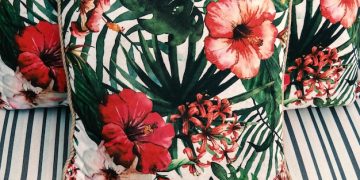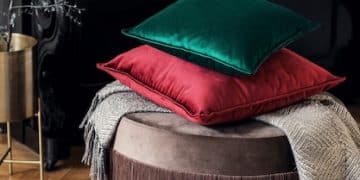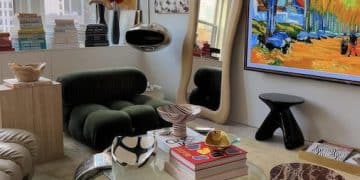The Ultimate Guide: Mixing and Matching Patterns for Home Decor

The ultimate guide to mixing and matching patterns in your home decor involves understanding scale, color palettes, and pattern types to create a cohesive yet visually stimulating space that reflects your personal style.
Mixing patterns in your home decor can feel like a daring adventure, however, the secret to a beautifully curated space lies in understanding how to harmoniously blend different designs. This the ultimate guide to mixing and matching patterns in your home decor will provide you with the knowledge to transform your space into a vibrant and stylish haven.
Understanding the Basics of Pattern Mixing
Before diving into the specifics, grasp the principles that underpin successful pattern mixing, helping you avoid clashes and create a cohesive look.
Establishing a Color Palette
A unified color palette is the backbone of any successful pattern mix. This doesn’t mean everything needs to be the same color, but rather the colors should complement each other. Think of using a primary color with a couple of accent colors to tie everything together.
Varying the Scale of Patterns
Mixing patterns of different scales is crucial for visual harmony. Combine large-scale prints with smaller, more intricate designs to prevent the patterns from competing with each other. A large floral print on curtains paired with a small geometric pattern on cushions is a classic example.

Here are some key considerations for varying the scale of patterns:
- Large-Scale Patterns: Use these sparingly to make a statement.
- Medium-Scale Patterns: Incorporate these to add depth and complexity.
- Small-Scale Patterns: These can act as neutrals, tying the larger patterns together.
Understanding the basics of pattern mixing ensures a balanced and aesthetically pleasing decor, giving the room depth and personality.
Identifying Different Types of Patterns
Familiarizing yourself with different pattern types is essential for creating a diverse and engaging decor scheme.
Geometric Patterns
Geometric patterns, such as stripes, chevrons, and polka dots, are versatile and easy to integrate into various decor styles. Simple stripes and polka dots offer more flexibility in combining patterns.
Floral Patterns
Floral patterns bring nature into your home. These can range from delicate, small-scale prints to bold, large-scale designs. Consider the specific type of floral pattern to best suit the room’s theme.
Remember:
- Damask patterns offer timeless elegance, often seen in classic interiors.
- Paisley patterns add a touch of bohemian flair, with intricate designs that catch the eye.
- Abstract patterns provide a modern twist, perfect for contemporary spaces.
By recognizing different pattern types, you can create depth and visual interest, enhancing the overall aesthetic.
Building a Cohesive Look
Creating a cohesive look when mixing patterns requires careful planning and an understanding of how different patterns interact.
Start with a Neutral Base
Beginning with a neutral base allows you to add patterns without overwhelming the space. Neutral walls, furniture, and flooring provide a calming backdrop that lets the patterns shine.
Mix Patterns within the Same Color Family
Using patterns within the same color family is a foolproof way to create harmony. Different shades and tones of the same color can create a subtle yet visually interesting effect. Utilizing analogous colors creates a pleasing visual effect without clashing.

Here’s how to mix patterns effectively:
- Identify the Primary Color: Choose a dominant color for your space.
- Select Complementary Patterns: Find patterns that share and enhance the color palette.
- Ensure Balance: Distribute the patterns evenly across the room.
Through a cohesive color story, the patterns work together to create a unified and harmonious design.
Balancing Bold and Subtle Designs
Achieving balance between bold and subtle patterns is key to creating a sophisticated and well-curated interior.
Using Bold Patterns as Focal Points
Bold patterns can serve as focal points, drawing the eye and adding drama to a room. Use these patterns sparingly, such as on an accent wall or a statement piece of furniture.
Incorporating Subtle Patterns for Texture
Subtle patterns add texture and depth without overwhelming the space. These can be incorporated through rugs, curtains, or smaller accessories. Using soft patterns balances bolder designs in the room.
Key Points:
- Contrast is Essential: Combine patterns that differ in size and intensity.
- Layer Patterns: Start with a neutral base and add patterns in layers.
- Edit Ruthlessly: Remove any patterns that don’t enhance the overall look.
Balancing bold and subtle designs ensures a space that is visually interesting yet harmonious, enhancing the overall aesthetic.
Common Mistakes to Avoid
Avoiding common mistakes is essential for successful pattern mixing. Understanding what NOT to do can save you from creating a chaotic or overwhelming space.
Overusing Too Many Patterns
One of the biggest mistakes is using too many patterns in a single space. This can result in a cluttered and overwhelming look. Limiting the number of patterns helps maintain balance and visual clarity.
Ignoring Scale and Proportion
Failing to consider the scale and proportion of patterns can lead to visual discord. Mixing patterns that compete with each other, such as two large-scale prints, can create an unbalanced look.
Avoid these pattern mixing pitfalls:
- Lack of Color Coordination: Ensure all patterns share a common color palette.
- Forgetting Solid Colors: Solid colors provide necessary visual breaks.
- Neglecting Texture: Texture adds depth and interest to the mix.
By avoiding these common mistakes, you can create a more balanced and sophisticated look, showcasing your design expertise.
Practical Tips for Success
Success in pattern mixing comes with practical application and a keen eye for detail. By incorporating these tips, you can create stunning and unique decor schemes.
Use Throw Pillows to Experiment
Throw pillows are an easy and affordable way to experiment with different patterns. You can mix and match pillow covers to see what works before committing to larger pieces. Using throw pillows as test subjects can save time and money.
Start Small and Build Up
Begin with a few patterns and gradually add more as you become more comfortable. Starting small allows you to refine your choices and avoid overwhelming the space. Add patterns gradually and assess the overall effect.
Essential Pattern Mixing Tips:
- Incorporate Texture: Use textured fabrics to add depth to your pattern mix.
- Consider the Room’s Purpose: Tailor your pattern choices to the room’s function.
- Trust Your Instincts: Ultimately, choose patterns that you love.
Following these practical tips will enhance your confidence and skill in pattern mixing, transforming any room with creativity and flair.
| Key Point | Brief Description |
|---|---|
| 🎨 Color Palette | Unify patterns with a cohesive color scheme. |
| ⚖️ Pattern Scale | Mix large, medium, and small-scale patterns. |
| ✨ Neutral Base | Start with neutral backgrounds to balance patterns. |
| 💡 Focal Points | Use bold patterns sparingly to draw attention. |
Frequently Asked Questions
▼
Start with a neutral base and then introduce patterns gradually. Begin with throw pillows or small accessories to experiment before committing to larger pieces like furniture or curtains.
▼
Select a primary color and a couple of accent colors that complement it. Using different shades and tones of the same color can create a harmonious and visually appealing effect without overwhelming the space.
▼
Mixing geometric, floral, and abstract patterns can create a dynamic and engaging look. Just be sure to vary the scale of the patterns and maintain a consistent color palette to tie everything together seamlessly.
▼
A good rule of thumb is to use no more than three to five patterns in a room. This allows for visual interest without creating a cluttered or overwhelming feel. Balance is key for a sophisticated and well-curated space.
▼
Avoid using too many patterns, ignoring scale and proportion, lacking color coordination, forgetting solid colors, and neglecting texture. These can lead to visual discord rather than harmony in your decor.
Conclusion
Mastering the art of mixing and matching patterns can transform your home into a stylish and personalized sanctuary. By understanding the basics of color palettes, pattern types, and scale, you can create a cohesive and visually stimulating space that reflects your unique taste and design sensibilities.





